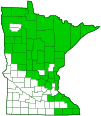one-sided wintergreen
(Orthilia secunda)
Conservation • Wetland • Description • Habitat • Ecology • Use • Distribution • Taxonomy
Description |
||
One-sided wintergreen is a common but often overlooked plant in northern and mountain forests. It is native, widespread, and common across the Northern Hemisphere. In the United States it is common in New England, the Upper Midwest, and the West, absent from the South and Lower Midwest. In Minnesota it is very common in the Arrowhead and north-central regions, less common in the Metro and southeast regions, and absent from the southwest. It is found in deciduous, coniferous, and mixed forests, and in bogs. It grows in dry to moist soil under full to partial shade. In Minnesota it is found mostly on moist, mossy forest floors. It obtains about half of its nutrients from the underground fungal (mycorrhizal) network that assists other plants in absorbing nutrients from the soil. One-sided wintergreen is an erect, perennial, long-lived forb that rises on a single stem from a forking, underground, horizontal stem (rhizome). It can be 4¾″ to 13″ (12 to 33 cm) tall, but is usually less than 7⅞″ (20 cm) in height. The leaves are evergreen, ¾″ to 1⅞″ (20 to 47 mm) long, and ¼″ to 1⅛″ (7 to 28 mm) wide. They are firm and sometimes have an almost leathery texture. They appear basal, rising from the rhizome, but are actually clustered on the stem near the base. They appear to be in whorls, emerging from the same point on the stem, but are actually alternate or in pseudowhorls, very closely spaced but emerging at separate points on the stem. There are usually 2 to 4 pseudowhorls, sometimes just 1. Each leaf is on a hairless, ⅛″ to ¾″ (4 to 20 mm) long stem (petiole). The petiole is channeled above. The leaf blade may be egg-shaped or broadly egg-shaped, widest near the base; elliptic, widest at the middle; or nearly circular. It is rounded to narrowly angled at both ends. The upper surface is shiny, green, and hairless. The lower surface is dull, light green, and hairless. The margins are flat, rarely somewhat rolled toward the underside. It may be untoothed or have fine rounded teeth. It does not have sharp teeth. The stem may be erect or lay on the ground with just the tip curved upward (decumbent). There is no visible point where the short stem ends and the long inflorescence stalk (peduncle) begins. Both are hairless and green or slightly reddish. The stem is unbranched, leafy, and smooth to the touch. The peduncle is unbranched and leafless but usually has minute, pimple-like protuberances (papilla), especially dense toward the top. There are usually 2 to 5 small modified leaves (bracts) on the peduncle, but these may be absent. The bracts are narrowly or broadly lance-shaped, ⅛″ to ⅜″ (3 to 9 mm) long, and 1⁄32″ to 1⁄16″ (1 to 2 mm) wide. The inflorescence is a ¾″ to 2″ (2 to 5 cm) long, unbranched cluster (raceme) of flowers at the end of the stem. There are usually 6 to 20 flowers but there may be as few a 2 or as many as 29. They hang downward from one side of the arcing tip of the peduncle. Each flower is ¼″ to ⅜″ long, bell-shaped, and as long or longer than wide. It hangs from a ⅛″ to ¼″ (3 to 7 mm) long flower stalk (pedicel). At the base of each pedicel, but not attached to the pedicel, is a scale-like, awl-shaped or more or less lance-shaped bract. The bract is about the same length as the pedicel. There are 5 outer floral leaves (sepals), 5 petals, and 10 stamens, and 1 style. The sepals are fused just at the base then broadly separated into 5 broadly triangular to egg-shaped lobes. They are green but may have white or pinkish margins. The petals are white, 3⁄16″ to ¼″ (4.5 to 6.0 mm) long, and ⅛″ (3 to 4 mm) wide. The stamens protrude just beyond the petals. The style is green, stout, and long, protruding far beyond the petals. The fruit is a flattened globe-shaped, ⅛″ to 3 ⁄16″ (3 to 5 mm) long, ⅛″ to ¼″ (4 to 6 mm) in diameter capsule. When in fruit the peduncle straightens and elongates and the pedicels straighten so that the capsules are stiffly held more or less parallel to the ground. The infructescence (all of the fruits) is up to 3⅛″ (8.5 cm) long. |
||
Height |
||
4¾″ to 7⅞″ (12 to 20 cm) |
||
Flower Color |
||
White |
||
Similar Species |
||
Habitat |
||
Dry to moist. Deciduous, coniferous, and mixed forests; and bogs. Full to partial shade. |
||
Ecology |
||
Flowering |
||
June to July |
||
Nutrition |
||
One-sided wintergreen grows in the often deep shade of northern forests. In 2007 it was discovered that it obtains about half of its nutrients from the underground fungal (mycorrhizal) network that assists other plants in absorbing nutrients form the soil. |
||
Use |
||
|
||
Distribution |
||||
|
Sources |
|||
| 9/20/2021 | ||||
Nativity |
||||
Native |
||||
Occurrence |
||||
Common |
||||
Taxonomy |
|||
| Kingdom | Plantae (Plants) | ||
| Division | Tracheophyta (Vascular Plants) | ||
| Subdivision | Spermatophytina (Seed Plants) | ||
| Class | Magnoliopsida (Dicots) | ||
Order |
Ericales (heathers, balsams, primroses, and allies) | ||
Family |
Ericaceae (heath) | ||
| Subfamily | Pyroloideae | ||
| Tribe | Pyroleae | ||
Genus |
Orthilia | ||
Some authorities, including GRIN, place the tribe Pyroleae in the subfamily Monotropoideae. Others place it in the subfamily Pyroloideae. The Angiosperm Phylogeny Website, which should be the last word on naming of North American plants, places Pyroleae in the subfamily Pyroloideae. One-sided wintergreen was formerly placed in the genus Pyrola, and Pyrola was formerly placed in the family Pyrolaceae. In 2002, Pyrolaceae and four other families were placed in the heath family (Ericaceae). This species was placed in the new genus Orthilia based on the one-sided inflorescence and the longer, bell-shaped flower. It remains the only species in that genus. |
|||
Subordinate Taxa |
|||
Synonyms |
|||
Orthilia secunda var.obtusata Orthilia secunda var.obtusata Pyrola secunda Pyrola secunda ssp. obtusata Pyrola secunda ssp. obtusata Ramischia elatior Ramischia secunda |
|||
Common Names |
|||
one-sided orthilia one-sided pyrola one-sided wintergreen serrated-wintergreen sidebells wintergreen |
|||
Glossary
Bract
Modified leaf at the base of a flower stalk, flower cluster, or inflorescence.
Decumbent
Reclining on the ground but with the tip ascending.
Papilla
On plants: A tiny, rounded, nipple-like projection on the surface of a leaf or petal. On mushrooms: A small, raised, sharply pointed projection on the cap above the point of attachment with the stalk.
Pedicel
On plants: the stalk of a single flower in a cluster of flowers. On insects: the second segment of the antennae. On Hymenoptera and Araneae: the narrow stalk connecting the thorax to the abdomen: the preferred term is petiole.
Peduncle
In angiosperms, the stalk of a single flower or a flower cluster; in club mosses, the stalk of a strobilus or a group of strobili.
Petiole
On plants: The stalk of a leaf blade or a compound leaf that attaches it to the stem. On ants and wasps: The constricted first one or two segments of the rear part of the body.
Raceme
An unbranched, elongated inflorescence with stalked flowers. The flowers mature from the bottom up.
Rhizome
A horizontal, usually underground stem. It serves as a reproductive structure, producing roots below and shoots above at the nodes.
Sepal
An outer floral leaf, usually green but sometimes colored, at the base of a flower.
Stamen
The male reproductive organ of a flower consisting of an pollen-producing anther on a supporting filament.
Style
On plants: Part of the pistil, usually a slender stalk, connecting the ovary to the stigma(s). On flies (Diptera): A terminal, often slender or pointed, appendage arising from the end of the last, usually third, antennal segment.
Visitor Photos |
|||||
Share your photo of this plant. |
|||||
| This button not working for you? Simply email us at info@MinnesotaSeasons.com. Attach one or more photos and, if you like, a caption. |
|||||
|
|||||
MinnesotaSeasons.com Photos |
|||||
Flowering plant |
|||||
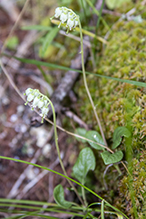 |
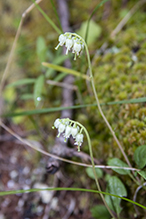 |
||||
Inflorescence |
|||||
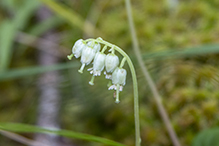 |
|||||
Fruiting pant |
|||||
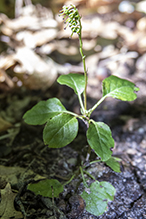 |
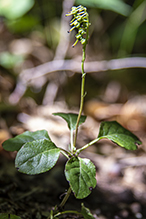 |
||||
Leaves |
|||||
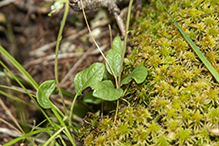 |
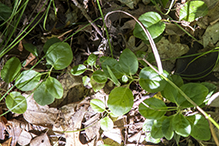 |
||||

Slideshows |
||

Visitor Videos |
|||
Share your video of this plant. |
|||
| This button not working for you? Simply email us at info@MinnesotaSeasons.com. Attach a video, a YouTube link, or a cloud storage link. |
|||
Other Videos |
|||
| An Herbal Adventure; Pyrola Orthilia secunda Lumara Rose |
|||
About
Jul 27, 2016 Another species in the orchid family; Sidebells Pyrola Orthilia secunda... these lovely specimens are so delicate. I love how there are many little bells unlike their relative with only a single bell Pyrola uniflor Single delight. Wish the footage was clear, but I hope you get the idea. Hit the "Like" button, Click "SUBSCRIBE", Comment Below, and Share this Video! See what Herbal Adventures I'm up to on Facebook & please feel free to like & share Here: https://www.facebook.com/freespiritan... Find Me on Instagram: https://www.instagram.com/lumararose/ Find me on Pinterest here: https://www.pinterest.com/lumararose/ Check out My herbal STORE Here: https://freespiritandmind.com/shop Check out my Etsy store here: https://etsy.com/shop/FreeSpiritandMind Check out my website at www.freespiritandmind.com to follow my blog! Have you been looking for a great tincture to add to your Medicinal Arsenal? If so Help Support Local Phoenix herbalist for your herbal remedy purchases! If you do not want to Purchase directly off the website & you are Local to the Phoenix are PM me or email @ freespiritandmindaz@gmail.com for personal delivery. Check out other listings on the website at https://www.freespiritandmind.com/shop, Etsy at https://www.etsy.com/shop/FreeSpirita... or Pinterest. Email me at: freespiritandmindaz@gmail.com |
|||

Visitor Sightings |
|||||
Report a sighting of this plant. |
|||||
| This button not working for you? Simply email us at info@MinnesotaSeasons.com. Be sure to include a location. |
|||||
|
|
||||
MinnesotaSeasons.com Sightings |
|||||

Created: 2/23/2020
Last Updated:
